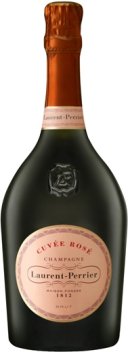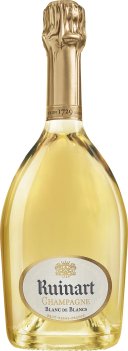$100 and over
Les Clos Pompadour in timber box
Within the Estate of Pommery in the heart of Reims are 25 hectares or walled vineyards called the Clos Pompadour. Amongst the best terroirs of Champagne, this Clos (walled vineyard) is able to sublimate the greatest vintages. A meticulous selection of the most beautiful grapes of the three champagne varieties, reaching a perfect maturity thanks to a pure chalk subsoil and micro climate. Available in magnum size only, this cuvée is produced in very limited quantities.
Larmandier Bernier Longitude Non-Vintage
Laurent Perrier Rose
'Rose were for long regarded as the illegitimate offspring of Champagne, recipients of coarse, heavy pressings wines partially masked by high dosage levels. Today they are routinely priced above 'normal' NV (or vintage) blends and are carefully made. Whether they really merit the premium is irrelevant: the market has spoken. But Laurent-Perrier is a special case: this is 100% pinot noir, rather than a blend coloured by pinot noir red wine. The full salmon colour is an immediate indication of its provenance, the bouquet complex and alluring, leading directly into the cherry and strawberry flavours of the long, sustained palate; excellent finish and aftertaste.' - 95 points, James Halliday Top 100
Delamotte Brut Non-Vintage
Delamotte Blanc de Blancs Non-Vintage
Agrapart & Fils 7 Crus Extra-Brut Non-Vintage
Product Information: The NV Brut 7 Crus is a very pretty. Bright, mineral and intensely vibrant, the 7 Crus is full of energy and refreshment. 7 Crus is a blend of two harvests: in this case, 60% is 2021 from 1er Cru sites; and 40% is 2020 from Grand Cru sites. The reserve wine was raised in neutral, 600-litre oak casks from François Chidaine and Didier Dagueneau. The breakdown is 90% Chardonnay and 10% Pinot Noir. Even at this first level, the wine is aged for three years on lees. It was disgorged with 6 g/L dosage. This is the most immediately seductive cuvée in the Agrapart range, yet it is still extremely fine. It’s long, deep and saline with some gentle grip. Sadly, we do not get nearly enough. The reviews below refer to a previous disgorgement. Disg. March 2024. The Agrapart range begins with a non-vintage wine called 7 Crus. The name refers to the seven Côte des Blancs villages from which the wine derives. These include Avize (from younger vines aged 20 to 40 years), Cramant, Oger, Oiry, Avenay-Val-d’Or, Coligny and Vauciennes. Like all Agrapart wines, the fruit is from 100% estate-owned and farmed vineyards. Maker: In 1894 at the beginning of France’s lively Belle Époque “the beautiful era” or Europe's golden era between 1871 to 1914. Arthur Agrapart started the family domaine that would become Champagne Agrapart & Fils. The estate has weathered many storms, including World War I, an economic depression, and the German Occupation during World War II, which devastated stock by millions of cases throughout the region. In the 1950s, Arthur’s grandson Pierre set out to rebuild the family business by making wines of quality rather than following the commercial trends of the day. Pierre’s sons Pascal and Fabrice took over the reins in 1990, farming their own vineyards along the prestigious Côte de Blancs, as well as blending and bottling their own wines. By the early 2000s, upon realising the brothers did not have the same goals for the future of the estate, Pascal began the long-term process of dividing the estate in two. His vineyards would become the backbone of Domaine Pascal Agrapart, focusing on the unique single vineyard cuvées that he had championed since the early 1990s and the remaining family vineyards would provide the fruit for the assemblage cuvées, 7 Crus & Terroirs, still bottled under the Agrapart & Fils label today. Pascal has been joined by his eldest son Ambroise and their ultimate goal is to produce only wines bearing the Pascal Agrapart label. Philosophy: The winery is based in the grand cru village of Avize, famous for its cuvees of 100% Chardonnay. Pascal and Ambroise farm 10 hectares from some 60 different vineyard plots in the Côte de Blancs, including Oger, Cramant, Oiry and Avize. They farm using only homeopathic vine treatments, composts, manures, and regular plowing. The Agraparts were one of the first families to bring the draft horse back to the vineyards, and named a cuvee in honour of their first four-hooved friend, Vénus. In plowing the old-school way, they expose the clay and limestone soils to immune-boosting properties of the wind and sun. While they once were the object of ridicule, they now lead a return to authentic, ancestral practices. Their quality control extends to manual harvests, a selective triage of the grapes, and the use of native yeasts during fermentation. Malolactic fermentations are employed to round out the intensity of these mineral-driven Champagnes. The wines age on their lees for an extended period of time, and then are racked to both stainless steel and neutral oak barrels—the latter being a rarity in Champagne before Pascal started using them. All wines are bottled unfined and unfiltered. Nose - Apricots, Pears, Fennel Vibrant fruit here, with peaches, apricots, lemons, pears, almonds and spicy anise notes. Palate - Intense Minerality, Pillowy Palate, Citrus Peel medium to full-bodied, ample and pillowy palate. Finish - Chalk, Lingering Citrus, Saline White flowers, chalk and citrus linger.
Vincent Laval By Georges Laval Cumieres Rose Brut Nature Non-Vintage
Product Information: Georges Laval's Cumieres Rose Brut Nature NV is now produced by his son Vincent. This Champagne bursts from the glass, showing remarkable energy, tension and focus. Sweet floral and mint notes add an upper register to a wine that is first and foremost about minerality. This a 50/50 blend of Pinot Noir and Pinot Meunier; zero dosage; picked as whole bunches and carefully crushed by foot with a healthy amount of skin contact leading to a bold, vibrant red colour. Expect a rich, layered, detailed rosé unlike anything else you will have encountered. Maker: Four generations of the Laval family have been tending vines in Champagne and they have been producing estate bottled wines since the 1970’s. Georges Laval, Vincent’s father, was the first to begin bottling wines at the domaine in 1971. Vincent officially joined the family business in 1991 after finishing his studies, by 1996 he officially took the helm of the estate. Georges had set the standard for the quality of the wines coming from this tiny estate and Vincent has faithfully taken over the reins, without changing much. Taking note from a report written by Jacques Cousteau, Georges recognised the importance of farming organically very early on and accepted the responsibility of farming organically since 1971. The domaine was one of the first to make the conversion to organics, and for many years was one of only a handful of producers to farm in this manner. Philosophy: The Laval’s have about 2.5 hectares of vineyard holdings that they farm organically, certified Ecocert, along with some biodynamic practices. The Laval's go above and beyond to avoid any chemical overspray from neighbouring plots, in an effort to protect their soils & vines they go about treating about 30 additional acres of vines with their own organic treatments. They were even able to get all aerial treatment companies to distance their overhead treatments more than 15m from any of the families organic plots. They go as far as to trade parcels with other growers in order to have all their plots in specific lieu dits be all one cohesive healthy parcel as opposed to separate parcels throughout a given vineyard site. Above and beyond remember? All vineyard work is done by hand between just 4 people, including Vincent. Plowing is done by horse in all of their plots. All of their organic treatments and sprays are used only when necessary and with as little as possible. Nose - Vibrant Red Berries, White Flowers, Anise Vibrant aromas of fresh red berries and citrus fruits are complemented by suggestions of white flowers, anise and chalky minerals. Palate - Fleshy, Broad, Crackling Blood Orange Fleshy and broad but decidedly dry, offering crackling blood orange and bitter quince flavors that stretch out and deepen with air. Finish - Focused, Persistent Finish, Iodine Clings with excellent focus and tenacity on the strikingly persistent finish, which leaves notes of orange pith and iodine behind.
House of Arras Blanc de Blancs
Australia's premier sparkling winemaker, Ed Carr, produces elite sparkling wines that border on the perfection. The equal to any prestigious Champagne, House of Arras have a track record of releasing Australia's finest examples. Here the new Arras Blanc de Blancs is the latest to join the range and is a sparkling wine that truly expresses the attributes of prestige Tasmanian Chardonnay, meticulous winemaking and extensive age on yeast lees. Hands on techniques including gentle whole bunch pressing, fermentation on light lees which went through 100% malolactic and almost 10 years in tirage were employed. The wine itself is a masterpiece that possesses a brilliant clarity and ultra-fine persistent bead. Lifted citrus of grapefruit and lemon zest are complimented with buttered toast.
Louis Roederer Brut Nature
Ruinart Blanc de Blancs Non-Vintage
The House of Ruinart stands in a league of its own, defying convention and captivating with its unique legacy. Founded in 1729, it holds the distinction of being the very first Champagne House, a visionary endeavour inspired by the foresight of a monk who possessed a remarkable intuition far beyond his era. In the heart of the Champagne region, specifically in Reims, a significant moment unfolded on September 1st, 1729. It was then that Nicolas Ruinart, driven by the profound influence of his visionary monk uncle, drafted the historic charter that marked the birth of Maison Ruinart, forever etching its name as the world's pioneer in champagne production. Little did they know that this bold initiative would pave the way for an enduring enterprise that thrives and prospers even after nearly three centuries, leaving an indelible mark on the course of history. During the remarkable period of the mid-18th century, Ruinart made a significant acquisition to enhance its champagne production. The House secured ownership of ancient crayères, subterranean chalk quarries meticulously carved beneath the historic city of Reims. These extraordinary caverns served as the ideal sanctuary for storing their precious bottles, ensuring optimal aging and maturation. Building upon its reputation for innovation, Ruinart continued to push boundaries. In 1764, the House achieved yet another milestone by successfully shipping the first-ever Rosé champagne across the vast expanse of Europe. This ground-breaking achievement introduced a new dimension to the world of champagne, captivating connoisseurs with its captivating hues and captivating flavors. Bestowed with nobility and adopting the esteemed name Ruinart de Brimont in 1817, the family has diligently guided the House for over two centuries. With each passing generation, a new Head of House emerges, bringing forth their unique talents and unwavering commitment to serve the lineage of Ruinart. This steadfast succession ensures the preservation of the family's legacy, as each successor devotes themselves to upholding the traditions and values that define Ruinart. Their collective efforts have propelled the House to unparalleled heights, solidifying its reputation as a bastion of excellence in the world of champagne. Ruinart Blanc de Blancs embodies purity of the Chardonnay grapes from which it is made exclusively. Made primarily with Premiers Crus from the Cote des Blancs, and Montagne de Reims Terroirs, it is intensely aromatic. The blend is 100% Chardonnay from various years (20 to 25% of which are reserve wines from the 2 previous years). The nose is powerfully reminiscent of fresh fruits with dominant notes of citrus and exotic fruits, followed by a touch of jasmine, white peaches and pink peppercorns. A perfect champagne for aperitifs, particularly in spring and summer. It is an excellent complement to seafood and shellfish; perfect with a sea bass or bream tartare. It would also be very good with seared sole. Note - this item does not come with a gift box.








